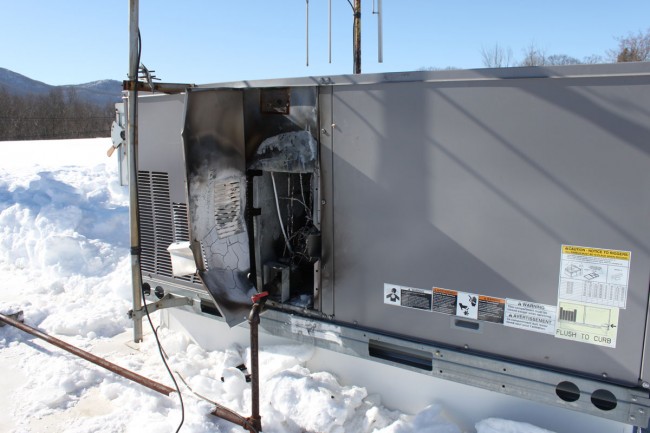We don’t need no water, let the… oh, wait… The actual roof is actually on fire you say?
YES: Ahh! Time to run around like crazy people!

This happened over the weekend at one of our clients in NY. The back story is this; over the last two weeks, the area has received almost three feet of snow. This roof is pitched slightly toward the back of the building. The roofing material is some type of PVC, which is very slippery when wet. Thus, at some point the snow/ice pack shifted towards the back of the building, and it broke the natural gas pipe off where it entered the unit:

The next time the HVAC unit cycled on, there was a giant torch on the roof with flames reportedly eight feet high. A local firefighter just happened to be driving down the road and spotted the fire, thus likely saving the building from major damage. The fire department came and cut off the gas and electricity. The building was evacuated for about 20 minutes while they overhauled and checked for internal fires.

A second unit suffered the same fate, only with less damage:

The fire in this unit was contained in the controller area. Same situation with the gas pipe, only it looks like the pipe was not broken all the way off:

The other two units are shut off while the gas pipes are dug out of the snowpack and checked for damage. At some point, they will be turned back on so that the heat can be restored to the second-floor sales bullpen. Meanwhile, the salespeople; are complaining.
We threw a tarp over the unit with the cover ripped off because more snow is on the way:







I bet they use a flex line from now on. Probably should retrofit the other units too.. Glad it wasn’t any worse.
Mark
Yeah, those pipes do look a bit rusty and seem to have snapped rather cleanly. Also, not much room for expansion with such a system. At least on a generator there’s a piece of flexible rubber hose at the end for vibration, but the same thing could happen if all that much ice and snow moves around. I have seen the roof of my truck bend when the snow on top moved and tried to take the roof-mount antenna along with it. This year I pulled the antenna and capped it but the AM/FM radio antenna is suffering the same fate.
I’d check the regulator (located on the gas meter) for proper pressure. Should be around 2 lbs or so.
Holy cow! Disaster narrowly averted. The station where I work stopped allowing non-flexible electrical conduit to HVAC equipment some years ago, but the elderly ceiling-hung gas heaters still have rigid black-iron pipe* running to them; at least it’s not as exposed as the ones in your posting but it’s still a good thing to keep an eye on. Except for the bright-yellow jacket, modern flexible gas-pipe looks like Seal-Tight flexible conduit and uses similar methods to hang and connect. It wouldn’t do any better against shifting snow-pack, though.
This year’s snows have presented all manner of interesting challenges. Running a UHF LPTV on a large (and fully radomed) antenna previously used for a 1 MW (ERP) DTV transition station, we discovered that when it ices up, there’s significant attenuation, as in “are we on the air?” The SWR isn’t too bad (and the DTV “saddle filter” uses two offset filters in parallel with Magic Tees at input and output, so the reflected power goes right into a dummy load before the transmitter finals “see” it) but it only barely gets out! We never noticed this with a Megawatt out, so either there was sufficient heating that the ice slid off before it built up too much, or there was enough extra RF that the loss didn’t take the signal over the “cliff.”
_______________________
* Galvanized pipe is generally not allowed for heating gas (local codes vary) and mixing the two is an especially poor idea, as there’s preferential corrosion. I would not know this except I’ve had to have some of the gas plumbing in my basement replaced after it began to leak where a galvanized coupler had been used decades earlier.
I am not sure that flex would have prevented this situation althought it may have changed the timing somewhat. It was simply a bad installation design, the pipe should have been run inside and up into the bottom of each unit. In the end, I think all four of these units around going to be replaced with something different, they have been nothing but trouble since they were installed.
Just anchor the piping down since the HVAC units aren’t going anywhere. This looks just like a lot of roof top installs. In fact look like the roof at where I work.
On flex — the issue is avoiding long-term wear due to vibration, which makes it easier for the stuff to break under stress. Agreed, not a factor here.
After years of dealing with the long-term consequences of “it’ll stay put by it’s own weight,” I have become a very fervent advocate of bolting down even very heavy devices, like racks and transmitters. They don’t walk very fast but once they do…it’s a mess.